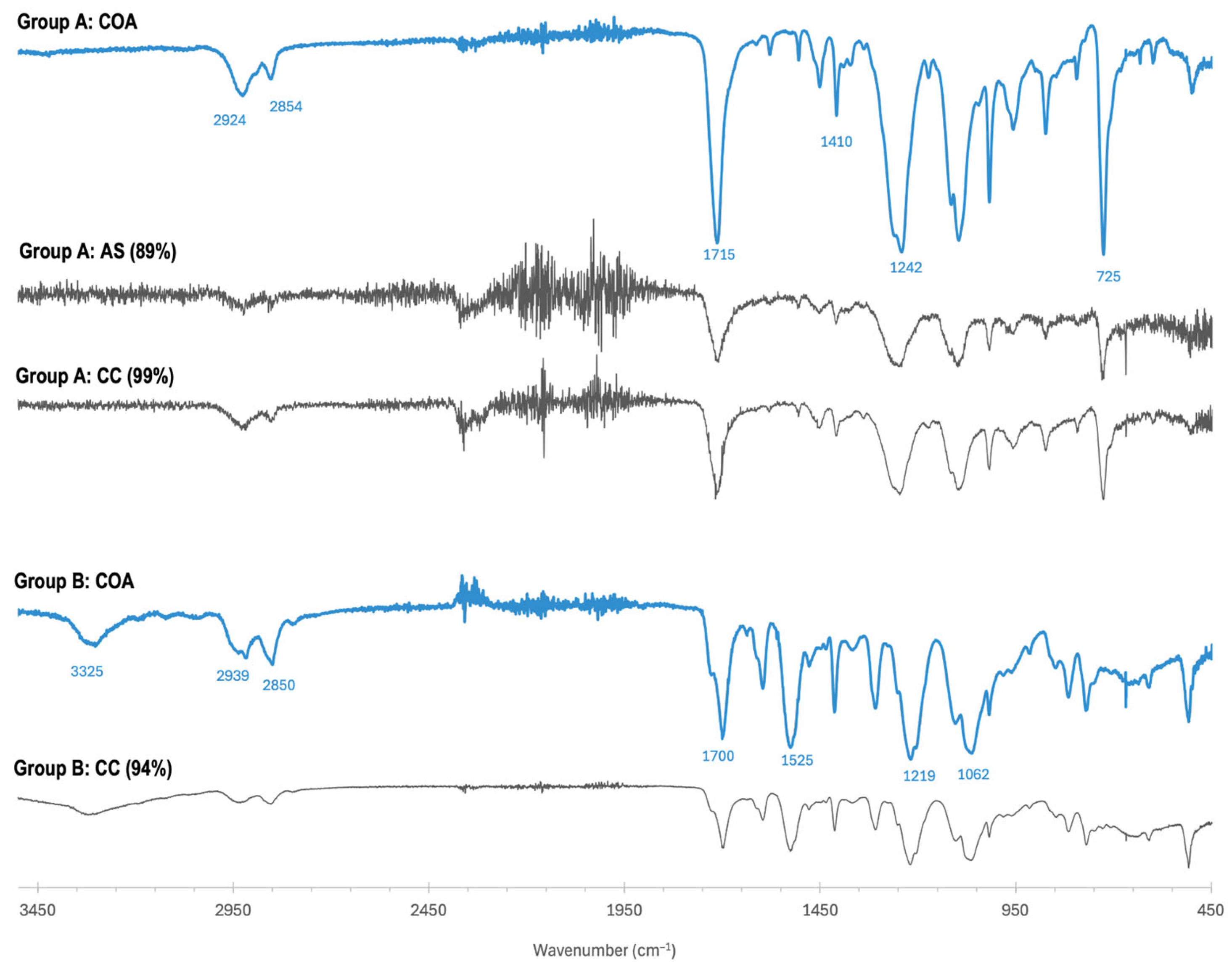Influence of Coca-Cola® on Thermoplastic Degradation in Clear Orthodontic Aligners †
7th CiiEM International Congress 2025—Empowering One Health to Reduce Social Vulnerabilities
)
Abstract
1. Introduction
2. Materials and Methods
3. Results
4. Discussion
5. Conclusions
Author Contributions
Funding
Institutional Review Board Statement
Informed Consent Statement
Data Availability Statement
Conflicts of Interest
References
- Al-Nadawi, M.; Kravitz, N.D.; Hansa, I.; Makki, L.; Ferguson, D.J.; Vaid, N.R. Effect of clear aligner wear protocol on the efficacy of tooth movement: A randomised clinical trial. Angle Orthod. 2021, 91, 157–163. [Google Scholar] [CrossRef] [PubMed]
- Bernard, G.; Rompré, P.; Tavares, J.R.; Montpetit, A. Colorimetric and spectrophotometric measurements of orthodontic thermoplastic aligners exposed to various staining sources and cleaning methods. Head Face Med. 2020, 16, 2. [Google Scholar] [CrossRef] [PubMed]
- Warnecki, M.; Sarul, M.; Kozakiewicz, M.; Zięty, A.; Babiarczuk, B.; Kawala, B.; Jurzysynk, Z. Surface evaluation of aligners after compulsory teeth immersion in Coca-Cola and orange juice. Materials 2022, 15, 6341. [Google Scholar] [CrossRef] [PubMed]
- Bucci, R.; Rongo, R.; Levaté, C.; Michelotti, A.; Barone, S.; Razionale, A.V.; D’Antò, V. Thickness of orthodontic clear aligners after thermoforming and after 10 days of intraoral exposure: A prospective clinical study. Prog. Orthod. 2019, 20, 36. [Google Scholar] [CrossRef] [PubMed]
- Quinzi, V.; Orilisi, G.; Vitiello, F.; Nofrasterino, V.; Marzo, G.; Orsini, G. A spectroscopic study on orthodontic aligners: First evidence of microplastic dispersion after seven days of clinical use. Sci. Total Environ. 2023, 886, 161356. [Google Scholar] [CrossRef] [PubMed]
- Otorkpa, O.J.; Otorkpa, C.O. Health effects of microplastics and nanoplastics: Review of published case reports. Environ. Anal. Health Toxicol. 2024, 39, e2024020. [Google Scholar] [CrossRef]
- Choi, H.; Kaneko, S.; Suzuki, Y.; Inamura, K.; Nishikawa, M.; Sakai, Y. Size dependent internalization of microplastics and nanoplastics using in vitro model of the human intestine—Contribution of each cell in the tri-culture models. Nanomaterials 2024, 14, 1435. [Google Scholar] [CrossRef] [PubMed]
- Wang, X.; Deng, K.; Zhang, P.; Chen, Q.; Magnuson, J.T.; Qiu, W.; Zhou, Y. Microplastic-mediated new mechanism of liver damage: From the perspective of the gut-liver axis. Sci. Total Environ. 2024, 919, 170962. [Google Scholar] [CrossRef] [PubMed]
- Gal, J.Y.; Fovet, Y.; Adib-Yadzi, M. About a synthetic saliva for in vitro studies. Talanta 2001, 53, 1103–1115. [Google Scholar] [CrossRef]


Disclaimer/Publisher’s Note: The statements, opinions and data contained in all publications are solely those of the individual author(s) and contributor(s) and not of MDPI and/or the editor(s). MDPI and/or the editor(s) disclaim responsibility for any injury to people or property resulting from any ideas, methods, instructions or products referred to in the content. |
© 2025 by the authors. Licensee MDPI, Basel, Switzerland. This article is an open access article distributed under the terms and conditions of the Creative Commons Attribution (CC BY) license (https://creativecommons.org/licenses/by/4.0/).
Share and Cite
Pitschieller, M.; Pereira, D.; Delgado, A.S.; Ascenso, C. Influence of Coca-Cola® on Thermoplastic Degradation in Clear Orthodontic Aligners. Med. Sci. Forum 2025, 37, 10. https://doi.org/10.3390/msf2025037010
Pitschieller M, Pereira D, Delgado AS, Ascenso C. Influence of Coca-Cola® on Thermoplastic Degradation in Clear Orthodontic Aligners. Medical Sciences Forum. 2025; 37(1):10. https://doi.org/10.3390/msf2025037010
Chicago/Turabian StylePitschieller, Margarida, Dinis Pereira, Ana Sintra Delgado, and Carla Ascenso. 2025. "Influence of Coca-Cola® on Thermoplastic Degradation in Clear Orthodontic Aligners" Medical Sciences Forum 37, no. 1: 10. https://doi.org/10.3390/msf2025037010
APA StylePitschieller, M., Pereira, D., Delgado, A. S., & Ascenso, C. (2025). Influence of Coca-Cola® on Thermoplastic Degradation in Clear Orthodontic Aligners. Medical Sciences Forum, 37(1), 10. https://doi.org/10.3390/msf2025037010





